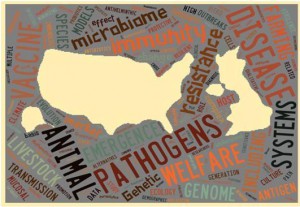11th September 2015 Houston, USA
Bugs Without Borders

Globalization, evolving pathogens, and a changing climate pose new challenges for disease control. This past June, the BBSRC, USDA-NIFA, RCUK-US, and UK SIN-US arranged a workshop for scientists and funders from the USA and the UK to meet in Washington D.C., to identify top priorities for research investment within Animal Health and Welfare, including Food Safety, Veterinary Vaccinology, and Antimicrobial Resistance. The final report from the workshop can be found here. The following is an editorial piece authored by several of the UK and US researchers involved in this transatlantic meeting and their assessment of the task at hand.
Authors:
Dr. Bryan Charleston MRCVS – Director of Science for the Pirbright Institute, specializing in livestock viral immunology and vaccinology
Dr. Fiona Tomley – Professor of Experimental Parasitology at The Royal Veterinary College, specializing in poultry disease, gut health, and vaccinology
Dr. Margie D. Lee – Professor of Population Health at the College of Veterinary Medicine at The University of Georgia
Human and animal pathogens do not respect national or political borders and there have been dozens of transnational disease outbreaks that pose serious threats to human and livestock health. Examples include the West Nile virus outbreak in the USA, African swine fever virus in Asia and Europe, and avian influenza currently affecting 15 states in the USA. The task of dealing with rapidly spreading diseases requires effective surveillance for early detection, a comprehensive understanding of disease epidemiology, and the development and delivery of effective control measures including vaccines.
Disease Spreading Through Resistance
Threats do not come from trans-boundary disease transmission alone. Anti-Microbial Resistance (AMR) in humans causes two million illnesses and 23,000 deaths each year in the USA. It is estimated that by 2050, AMR could kill 10 million people and cost $100 trillion (more than the current world economy). The global emergence and spread of AMR in humans is also linked with AMR found in the environment and in animals. Antimicrobials are being used in livestock and poultry, and along with humans, they are a potent reservoir of resistance genes which can be transmitted among microbial populations. There is urgent need to develop sustainable, effective, predictable, and safe alternatives for the control of microbe abundance, behavior, and transmission.
Effects on the Food Chain
To complicate matters more, it is estimated that global food production needs to double by 2030 while at the same time reducing the carbon footprint of agriculture. It is therefore crucial to recognize how antimicrobial resistant diseases in food animals threaten food security and sustainable intensification efforts. Recurring diseases have a significant impact on food animal health, welfare, and productivity causing occasional acute disease outbreaks with high mortality rates, but also causing chronic poor performance of food animals through reduction in fertility and increase in secondary infections. Some common viral and bacterial diseases can be controlled to some degree by vaccines, however many of these pathogens exhibit antigenic variation which, similar to the situation with the human flu virus, results in vaccine-resistant strains. Some diseases are also on the increase because of changes to climate and agricultural practices that allow the survival and dissemination of parasites and pathogens in the environment. Animal health researchers are challenged with the task of constant surveillance to determine whether commercially available vaccines are likely to be effective for strains that are currently causing disease.
The Intersection of Disease & Data
Interdisciplinary research, with integration of social and natural sciences, will be the key to success. The ‘big data’ era can allow us to develop comprehensive models to interrogate agricultural eco-systems. We must work with computer scientists to effectively integrate the high throughput molecular data with crucial information derived from very diverse sources such as records of climate and geography, animal movements, breed genetics, disease resistance phenotypes, nutritional and metabolic studies, and microbial interactions. One Health, which emphasizes the inextricable link between human, animal, and ecosystem health, is gaining considerable traction with funders; scientists in the UK and US are leading exponents of this important integrated area of science. It is imperative to bring the latest developments in bioscience and technology to bear on agricultural infectious disease research.
Implementation of successful control strategies and policies depends absolutely on clear, international co-operation to understand socio-economic, behavioral, and political drivers. As well as tracking the spread of AMR and monitoring the prevalence in food products, we must better understand the patterns of antimicrobial usage by veterinarians and farmers and find effective ways to influence this through farm-level, state, and international interventions and policies. The key to success is to improve coordination of interdisciplinary research efforts in order to maximize improvements in animal health and welfare, whilst protecting public health and ensuring the availability of wholesome food.